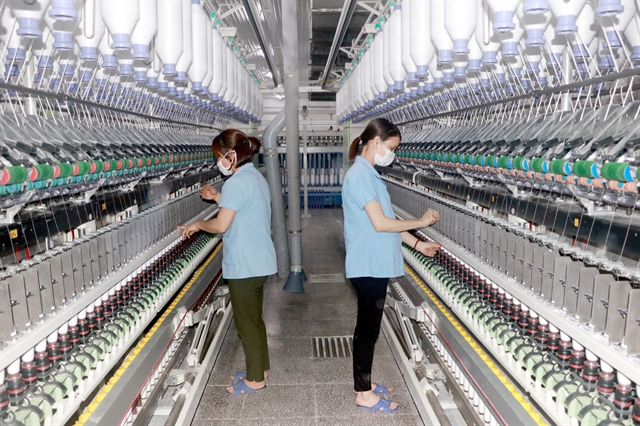Going green critical for the fashion industry to tap opportunities from trade deals
Going green is becoming vital for Việt Nam to tap opportunities arising from the UK – Việt Nam Free Trade Agreement (UKVFTA) to expand exports to the UK, the market which is aiming to develop a more circular fashion industry.
 |
|
Nam Định Textile Garment Joint Stock Company. The UKVFTA’s “fabric onwards” rules of origin were pushing the formation of a closed production chain from upstream to finished products. — VNA/VNS Photo |
Going green is becoming vital for Việt Nam to tap opportunities arising from the UK–Việt Nam Free Trade Agreement (UKVFTA) to expand exports to the UK, a market which is aiming to develop a more circular fashion industry.
In early September, the UK Fashion and Textile Association (UKFTA), the British Fashion Council (BFC), and UK Research and Innovation (UKRI) launched the Circular Fashion Innovation Network with a two-year ambition to create an industrial-scale change programme for the UK fashion and textile industry towards circularity and innovation.
Statistics from the General Department of Customs showed that Việt Nam’s export of garment and textile products to the UK reached $765 million in 2022, or 12 per cent of the UK’s total import from Việt Nam, an increase from the export value of $462 million in 2021.
A report by the Import–Export Department under the Ministry of Industry and Trade showed that Việt Nam was the 12th largest supplier of garment products to the UK in the 2017-21 period with a market share of around 2.2-2.8 per cent. During this period, the UK imported, on average, more than $20 billion worth of garment products each year, mainly from China and Bangladesh – the world’s two largest garment exporters.
According to the report, Việt Nam had competitiveness from the UKVFTA, but garment products from China were more competitively priced in the UK market, and Bangladesh still enjoyed preferential tariffs, being a developing country exporting to the UK.
There were significant opportunities to increase the export of garment products to the UK because this country was reducing imports from the EU and increasing imports from countries outside the bloc after Brexit, including Việt Nam.
It was essential for Vietnamese enterprises to meet requirements and standards for garment products to expand exports to the UK, the report said. One of the latest requirements was the UKCA marking, which came into force at the beginning of this year.
Under the UKVFTA, the UK removed 42.5 per cent of tariff lines on garment products from Việt Nam from January 1, 2021, and the rest are being eliminated within six years. By that time, competitors such as Bangladesh, Cambodia, and Pakistan would no longer have a competitive advantage in terms of tariffs.
The report pointed out that commitments to the rule of origin under the UKVFTA remain a significant challenge for Việt Nam’s textile and garment industry, which still heavily relies on imported fabrics and raw materials, around 70 per cent, and undertakes outsourcing contracts.
Thus, in the short term, the UKVFTA would not create a strong push for the garment and textile industry of Việt Nam like what was seen in the period of joining the World Trade Organisation or signing the Bilateral Trade Agreement with the US.
However, in the long term, the UKVFTA’s “fabric onwards” rules of origin, combined with the Comprehensive and Progressive Agreement for Trans-Pacific Partnership’s “yarn onwards”, would encourage the formation of a closed production chain from upstream to finished products, which would help increase added value.
“The UKVFTA is expected to bring long-term benefits to Việt Nam’s textile and garment industry in increasing exports to the UK, diversifying markets, and limit ing risks from global fluctuations,” the report wrote.
The solution to the fabric shortage and to benefit from the UKVFTA lies in the accumulation principle regarding the origin of fabric materials from the Republic of Korea, Japan, and the EU. Việt Nam could also use fabric imported from countries that have or will sign FTAs with the UK for production in Việt Nam. Thus, Vietnamese enterprises must enhance production capacity and seek trans-regional raw material supplies or develop domestic sources.
Furthermore, to expand exports to the UK, products must meet requirements concerning safety, environmental protection, and consumer health protection, the department stated in the report.
The department also encouraged Vietnamese garment firms to focus on human rights and climate change adaptation in production.
All the UKVFTA’s requirements prompted Vietnamese firms to enhance product quality to ensure sustainable export. This would be achieved by improving production capacity, establishing closed and sustainable value chains, innovating technology, diversifying products, building brands, and strengthening environmental, social, and corporate governance (ESG) along with accelerating digitalisation and green production.
According to Giang, the garment industry recognised that sustainable development was a crucial trend when targeting markets globally, especially those with new-generation FTAs.
Vietnamese enterprises should invest in green production, augment recycling, and set up closed value chains to create momentum for growth from 2023 onwards.
Giang predicted that garment exports would reach around $40 billion this year.
The garment export value was $44.5 billion in 2022, an increase of about 11 per cent compared to 2021, positioning Việt Nam as the third-largest exporter of garment products, following China and Bangladesh.








